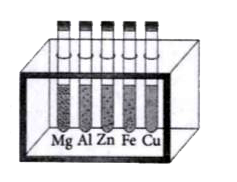Take about 10 ml of dilute hydrochloric acid in a test tube and add a few pieces of zine. granules into it. What do you observe? Why are bubbles formed in the solution? Take a burning candle near a bubble containing hydrogen gas, the flame goes off with "Popping' sound. This confirms that metal displaces hydrogen gas from the dilute acid.
Bubbles are formed as Zinc reacts with HC1 to form ZnCl and Hydrogen gas is released.
Topper's Solved these Questions
Similar Questions
Name two metals that can displace hydrogen from dilute acids to form metal salts and hydrogen gas.
View SolutionApparatus: Big test tube, delivery tube fitted in a rubber cork, knife, candle, etc.
Chemicals : Sodium metal, ethanol, magnesium ribbon, etc.
Procedure : Take 10 mL ethanol in a big test tube. Cut Sodium metal into 2-3 pieces of a cereal grain size. Put the sodium pieces into the ethanol in the test tube and fix the gas delivery tube to the test tube. Take a burning candle near the outlet of the gas delivery tube and observe.
Which is the combustible gas coming out of the gas delivery tube?
View Solution
Knowledge Check
A student takes some zinc granules in a test tube and adds dilute hydrochloric acid to it . He would observe that the colour of the zinc granules changes to
AwhiteBblackCbrownDyellow .Clean small pieces of magnesium, zinc, aluminium, iron and copper by rubbing them with a piece of sand paper. Take them in separate test tubes. Add about 10 mL of dilute hydrochloric acid to each of them.

Consider the following statements.
(i) The rate of evolution of hydrogen gas bubbles is not same in all the test tubes.
(ii) The rate of formation of bubbles is the fastest in the case of magnesium.
(iii) The reactivity decreases in the order:
Mg>Zn>Al>Fe>Cu.
(iv) In the case of copper, no bubbles are seen and the temperature also remains unchanged. This shows that copper does not react with dilute HCl.
Identify the correct option.AOnly (i) and (iv)BOnly (iii) and (iv)COnly (iii)DOnly (i), (ii) and (iv)
2 ml of sodium hydroxide solution is added to a few pieces of granulated zinc metal taken in a test tube. When the contents are warmed, a gas evolved which is bubbled through a soap solution before testing.
Name the gas which will be evolved when the same metal reacts with dilute solution of a strong acid.
View SolutionApparatus: Big test tube, delivery tube fitted in a rubber cork, knife, candle, etc.
Chemicals : Sodium metal, ethanol, magnesium ribbon, etc.
Procedure : Take 10 mL ethanol in a big test tube. Cut Sodium metal into 2-3 pieces of a cereal grain size. Put the sodium pieces into the ethanol in the test tube and fix the gas delivery tube to the test tube. Take a burning candle near the outlet of the gas delivery tube and observe.
Why do the sodium pieces appear to dance on the surface of ethanol?
View Solution2 ml of sodium hydroxide solution is added to a few pieces of granulated zinc metal taken in a test tube. When the contents are warmed, a gas evolved which is bubbled through a soap solution before testing.
Write a test to detect the gas.
View Solution2 ml of sodium hydroxide solution is added to a few pieces of granulated zinc metal taken in a test tube. When the contents are warmed, a gas evolved which is bubbled through a soap solution before testing.
Write the equation of the chemical reaction.
View SolutionApparatus: Big test tube, delivery tube fitted in a rubber cork, knife, candle, etc.
Chemicals : Sodium metal, ethanol, magnesium ribbon, etc.
Procedure : Take 10 mL ethanol in a big test tube. Cut Sodium metal into 2-3 pieces of a cereal grain size. Put the sodium pieces into the ethanol in the test tube and fix the gas delivery tube to the test tube. Take a burning candle near the outlet of the gas delivery tube and observe.
Repeat the above procedure using magnesium ribbon instead of sodium. Do you see gas bubble released from the piece of magnesium ribbon?
View SolutionApparatus: Big test tube, delivery tube fitted in a rubber cork, knife, candle, etc.
Chemicals : Sodium metal, ethanol, magnesium ribbon, etc.
Procedure : Take 10 mL ethanol in a big test tube. Cut Sodium metal into 2-3 pieces of a cereal grain size. Put the sodium pieces into the ethanol in the test tube and fix the gas delivery tube to the test tube. Take a burning candle near the outlet of the gas delivery tube and observe.
Repeat the above procedure using magnesium ribbon instead of sodium. Do you see gas bubble released from the piece of magnesium ribbon?
View Solution
